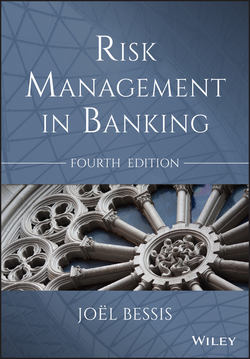Читать книгу Risk Management in Banking - Bessis Joël - Страница 11
На сайте Литреса книга снята с продажи.
1
RISKS AND RISK MANAGEMENT
1.4 Banking Regulations and Accounting Standards
ОглавлениеBanking activities are subject to a wide body of rules. Risks are subject to the regulations rules. Valuation of assets and liabilities and profit and loss are subject to accounting standards.
Risk regulations differ for the banking book and the trading book. The banking book refers to the transactions belonging to the core business of commercial banks, lending and deposit collection. It includes all assets and liabilities that are not actively traded by the institution, and generally held until they mature. The trading book groups capital market transactions, and is exposed to market risk. Positions held for trading are held over a short-term horizon, with the intention of benefiting from expected price movements. The trading book includes proprietary positions, and positions arising from client servicing and market making.
Risk regulations relate directly to the management of the balance sheet, to market risk and credit risk and are detailed in the corresponding sections of this text.
The accounting standards segregate instruments into four classes differing by valuation and treatment of profits and losses:
• Financial assets at fair value through profit and loss;
• Loans and receivables;
• Held-to-maturity investments;
• Available-for-sale financial assets.
The financial assets at fair value include all instruments acquired to take advantage of price fluctuations and are managed with the intention of making short-term profits, the performance of which is evaluated on a fair value basis. Derivatives are held for trading unless they are considered as hedges. The assets and liabilities of the trading book are under this category.
Fair value focuses on the price at which an asset can be sold: it is the amount at which an asset could be exchanged between parties, knowledgeable and willing to exchange. Valuation depends on whether markets are active or not. Active markets are those where the volume of transactions provide clear prices. For other instruments, prices can be derived from other traded instruments in active markets, or valuation is model based.
Accordingly, market instruments fall in either one of three categories: level 1 when quoted prices are available; level 2 when there are market prices for similar instruments; and level 3 for model valuation for instruments that are not extensively traded but have a value derived from models, or mark-to-model, such as options traded over the counter. Model valuation is recognized as fair value in the absence of an active market.
Loans and receivables are instruments with contractual payments and are not quoted in active markets. These assets are held in the banking book. In the banking book, income is determined according to accrual accounting rules of revenues and costs.
Held-to-maturity instruments are financial assets with contractual payments for which the management intention is not trading. Investment portfolios of banks' group financial assets, such as bonds, in which banks invest for the long term with no trading intent, are in this category. All other assets are available for sale.
Liabilities are either at fair value through profit and loss or other liabilities. The liabilities at fair value are held for trading, or designated as such, and the performance is based on fair value. The other liabilities include the normal financing of the bank, debt issued in markets or wholesale debt, which arises from lending and borrowing from other banks or financial institutions.
For the trading book, valuation is based on mark-to-market, or mark-to-model for illiquid instruments. The performance is evaluated on the basis of fair value: profit and loss (P&L) is measured as the variations of value between two dates.
